Vegetables
Profit in Potato-Digging
Undated. I'm guessing it's late 19th Century. From OddBook.ca:Maybe I should give up this blogging gig and start digging potatoes!


Posted By: Alex - Thu Apr 01, 2021 -
Comments (2)
Category: Self-help Schemes, Books, Vegetables, Nineteenth Century
Death by carrot juice
It was probably the enormous quantities of Vitamin A pills that Basil Brown was taking which actually killed him. Though the daily gallon of carrot juice certainly contributed.More info: NY Times
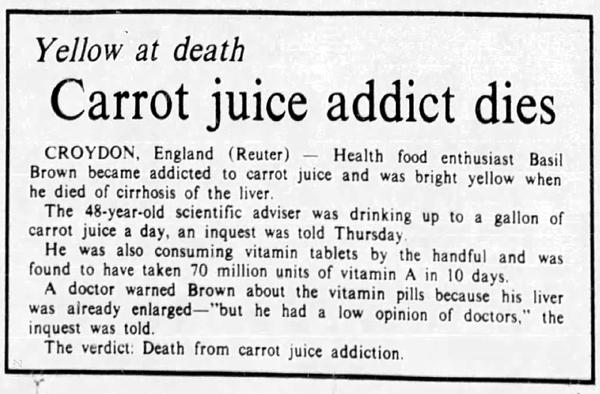
Ottawa Citizen - Feb 15, 1974
Posted By: Alex - Sun Jul 12, 2020 -
Comments (6)
Category: Death, Vegetables, 1970s
Veggie Cannibalism
We all know of the "animal cannibal" motif in ads. A chicken or cow or pig dressed as a chef invites the viewer to snack on his relatives. But I have never seen veggie cannibalism till this ad.Can WU-vies find other examples?
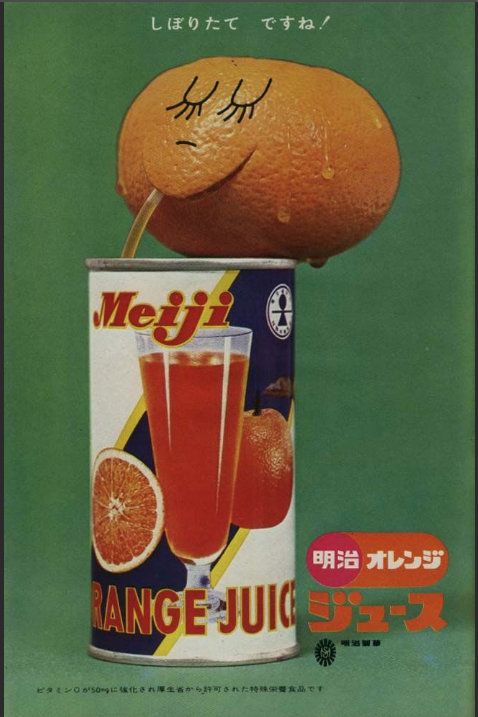
Posted By: Paul - Wed Apr 15, 2020 -
Comments (1)
Category: Animals, Business, Advertising, Cannibalism, Vegetables
Cucumber Sandwich Patent
Artist Alex Stenzel not only invented a cucumber sandwich, but in 2006 he managed to obtain a patent for it. It's a design patent, but a patent nonetheless.His idea was to hollow out a cucumber and stuff it with ingredients. He then used one end of the cucumber to plug up the other stuffed side. He called this a 'gorilla sandwich'.

The site dailytitan.com offers some details about how Stenzel came up with his idea:
The name 'Gorilla Sandwich,' according to Stenzel, was chosen after researching gorillas and discovering their diet consists of many greens that are high in protein.
"I'm very much into health," Stenzel said. "I've always been playing around with different types of herbs and different kinds of vegetables."
Stenzel, who is originally from an industrial area in Germany, came across this idea when confronted with a choice: eat his salad at home or store it inside a hollowed-out cucumber to make it portable enough to take to the beach with him. For Stenzel, who is a surfing enthusiast, the answer was obvious, and he was soon off to the beach to 'kiss the waves,' as he calls it, with his new edible invention. Stenzel also has had a world ranking for three different sports: tennis, mountain biking and the Iron Man World Championships in Hawaii in 1986.
"To reach the highest performance level possible, I experimented with different healthy diets," he said.
Stenzel has posted a series of videos on YouTube that provide complete instructions on how you can make your own gorilla sandwich.
Posted By: Alex - Wed Mar 25, 2020 -
Comments (0)
Category: Food, Vegetables, Inventions, Patents
Does holy water help radishes grow better?
In 1979, researcher Sandra Lenington of the University of Santa Clara set out to answer this question. Her curiosity had been sparked by learning that Canon William V. Rauscher had reported that “canna plants given holy water left over from use in religious services grew more than three times higher than canna plants which were not given holy water.” She decided to try to duplicate his observations under more rigorous conditions.
She watered one group of radishes with regular water, and a second group with holy water. After three weeks, she concluded that there was “no significant difference in the growth rates of these radish plants given holy water versus radish plants given tap water.” She published her results in the journal Psychological Reports (1979, 45, 381-382).
However, she noted that Canon Rauscher believed in the power of holy water, whereas she didn’t, and this may have affected the outcome of her study: “There are numerous documented studies showing that positive or negative belief will either benefit or adversely affect plant growth.” She suggested that future studies might try to better control for this variable.
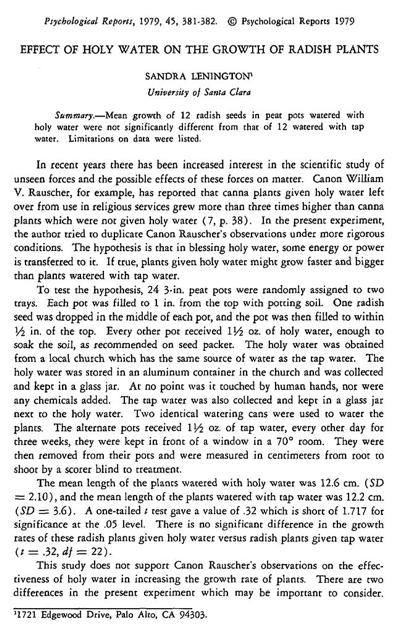
click to enlarge
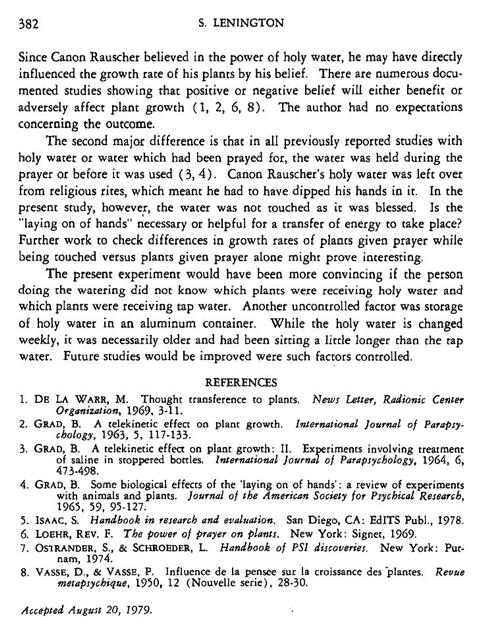
click to enlarge
Posted By: Alex - Sat Feb 01, 2020 -
Comments (3)
Category: Religion, Science, Vegetables, 1970s
Nutrimato
According to wikipedia:Nutrimato would have been a good name for a robot. Not so much for a juice drink.

Green Bay Press Gazette - Nov 8, 1972
Posted By: Alex - Mon Nov 05, 2018 -
Comments (3)
Category: Soda, Pop, Soft Drinks and other Non-Alcoholic Beverages, Vegetables, 1970s
Richard Nixon Eggplants
In May 1973, New York magazine ran a photo of an eggplant that looked like Richard Nixon. In 2017, the magazine's blog remembered it as "Maybe the funniest page New York has ever published."But it turns out that there were quite a few other Nixon-resembling eggplants reported in the news in '73 and '74. For a while it was quite the thing to do. I think there are just a lot of eggplants that look like Nixon.

New York Magazine - May 14, 1973
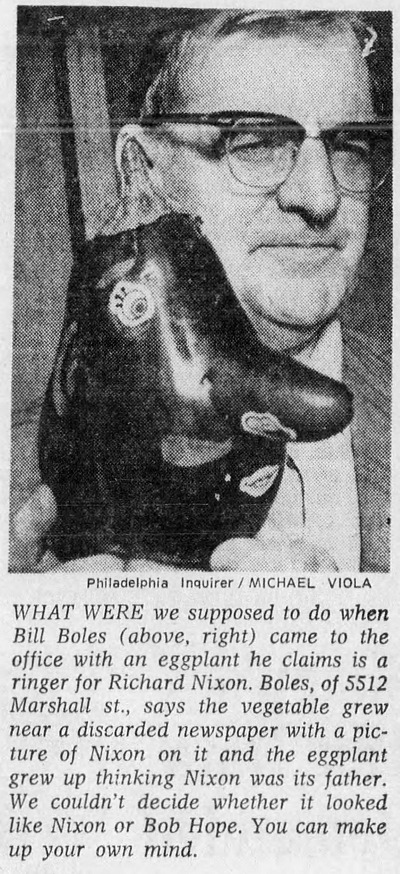
Philadelphia Inquirer - Sep 6, 1974

Gastonia Gazette - Aug 15, 1973

Hartford Courant - July 24, 1973

Denton Record Chronicle - Dec 10, 1973
Posted By: Alex - Wed Aug 29, 2018 -
Comments (3)
Category: Politics, Vegetables, 1970s
Vegetable Orchestra
They've got a great beet!Their website
Posted By: Alex - Mon Jul 16, 2018 -
Comments (2)
Category: Food, Vegetables, Music
Corn with odd number of rows

Hood County News-Tablet - Mar 17, 1966
Ears of corn almost always have an even number of rows. Foodreference.com explains the science:
When corn ears are found that have an odd number of rows, that's considered weird enough to make news. For instance, cases of odd-rowed corn surfaced in 1930 (found by Everett Kelderhouse of Collins, Iowa), 1941 (found by Ignac Sedlacek of Malmo, Nebraska), and 1949 (found by Alfred Kohnert of Calamus, Iowa).
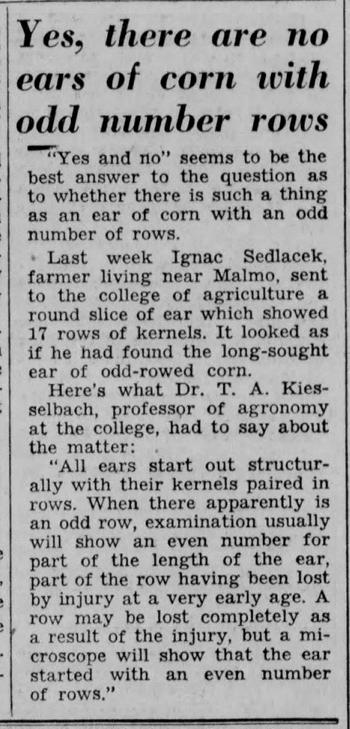
Lincoln Evening Journal - Oct 24, 1941

Carrol Daily Times - Sep 14, 1949
In popular culture, finding odd-rowed corn was sometimes used to make impossible-to-come-true promises. For instance, slaves might be told that they could have their freedom if they could find an ear of corn with an odd number of rows. But in the example below, recounted in Atheism and Arithemetic, Or, Mathematical Law in Nature (1885), one slave supposedly devised a way to find some odd-rowed corn:
Posted By: Alex - Wed Jul 13, 2016 -
Comments (0)
Category: Food, Vegetables
Vertical Farming; Its A Jersey Thing

A facility being built in New Jersey is going to be the world's largest vertical farming plant. AeroFarms is set to be 3 times bigger than the next largest place of its kind located in Japan. Water usage is much lower while yield is substantially higher than standard farming operations. It looks like something that would be used to grow food in a Mars colony or in an underground bunker after Armageddon. But perhaps we will find that solving world hunger is a Jersey thing.
Posted By: Alex - Tue Jun 07, 2016 -
Comments (4)
Category: Agriculture, Food, Vegetables, Horticulture and Gardens, Nature

| Who We Are |
|---|
| Alex Boese Alex is the creator and curator of the Museum of Hoaxes. He's also the author of various weird, non-fiction, science-themed books such as Elephants on Acid and Psychedelic Apes. Paul Di Filippo Paul has been paid to put weird ideas into fictional form for over thirty years, in his career as a noted science fiction writer. He has recently begun blogging on many curious topics with three fellow writers at The Inferior 4+1. Contact Us |




